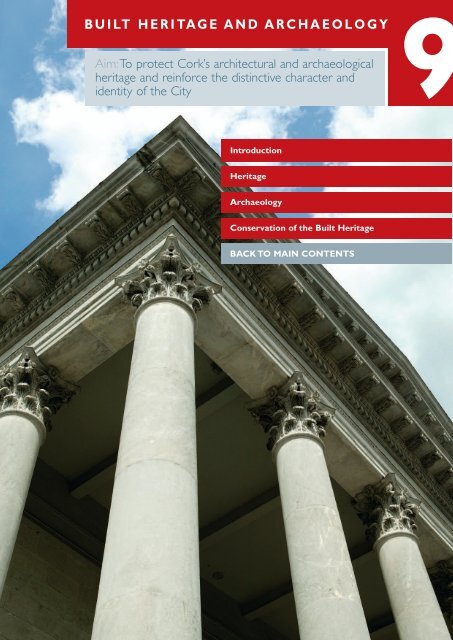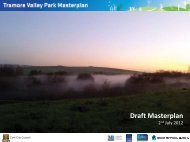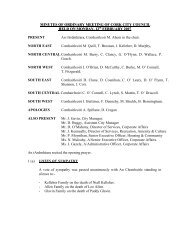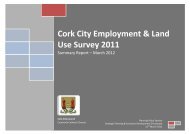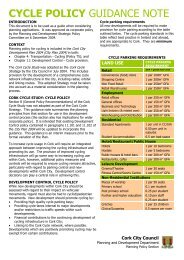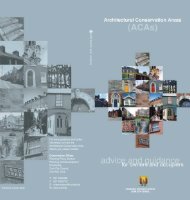Development Plan Chapter 9 Built Heritage - Cork City Council
Development Plan Chapter 9 Built Heritage - Cork City Council
Development Plan Chapter 9 Built Heritage - Cork City Council
Create successful ePaper yourself
Turn your PDF publications into a flip-book with our unique Google optimized e-Paper software.
BUILT HERITAGE AND ARCHAEOLOGY<br />
Aim:To protect <strong>Cork</strong>’s architectural and archaeological<br />
heritage and reinforce the distinctive character and<br />
identity of the <strong>City</strong><br />
9
9BUILT HERITAGE AND ARCHAEOLOGY<br />
Introduction<br />
9.1 This chapter includes an introductory section on the overall heritage of the city and the <strong>Heritage</strong> <strong>Plan</strong><br />
and then proceeds to focus on policies for archaeology and the conservation of the built environment.<br />
Overall Objectives<br />
• To promote the protection of the heritage of the city and the implementation of the <strong>Heritage</strong> <strong>Plan</strong>;<br />
• Ensure that elements of archaeological, architectural and other cultural significance are identified,<br />
retained and interpreted wherever possible and the knowledge placed in the public domain;<br />
• Promote the retention, reuse and enhancement of buildings and other elements of architectural or<br />
other significance;<br />
• Ensure that development reflects and is sensitive to the historical importance and character of the<br />
city, in particular the street layout and pattern, plot sizes, building heights and scales;<br />
• Improve and encourage access to and understanding of the architectural heritage of the city.<br />
<strong>Heritage</strong><br />
9.2 <strong>Heritage</strong> is defined under the <strong>Heritage</strong> Act 1995 as items such as monuments, archaeological objects,<br />
heritage objects, architectural heritage, flora, fauna, wildlife habitats, landscapes, seascapes, wrecks,<br />
geology, heritage gardens and parks and inland waterways.<br />
9.3 The importance of heritage was recognised by the Government by the publication of the National<br />
<strong>Heritage</strong> <strong>Plan</strong> in 2002. This <strong>Plan</strong> sets out a vision for the management of the national heritage. It<br />
recognises that conservation and management of our heritage plays an essential role in maintaining a<br />
high quality of life and recognises that our heritage is economically important particularly because of<br />
the role it plays in the tourist industry.The aim of the National <strong>Heritage</strong> <strong>Plan</strong> is to “ensure the protection<br />
of our heritage and to promote its enjoyment by all”. A key objective of the National <strong>Heritage</strong> <strong>Plan</strong> is<br />
to promote the role that local communities play in protecting and enhancing local heritage. This is<br />
achieved through the preparation and adoption of Local <strong>Heritage</strong> <strong>Plan</strong>s by the Local Authority.<br />
9.4 The <strong>Cork</strong> <strong>City</strong> <strong>Heritage</strong> <strong>Plan</strong> (2007-2012) sets out a series of realistic and practical<br />
actions to protect, conserve and manage the heritage of <strong>Cork</strong> <strong>City</strong> over the next<br />
five years.The aim of the <strong>Plan</strong> is “to secure the heritage of <strong>Cork</strong> <strong>City</strong>, to enrich the lives<br />
of its people and to ensure that the care of our heritage; past, present and future is at<br />
the heart of the development of the <strong>City</strong>”.The <strong>Plan</strong> identifies four objectives/themes<br />
to focus on for the lifetime of the <strong>Plan</strong>.These are:<br />
• To protect and enhance the natural, cultural and built heritage of <strong>Cork</strong> <strong>City</strong>;<br />
• To promote awareness, appreciation and enjoyment of the heritage of <strong>Cork</strong> <strong>City</strong>;<br />
• To promote interest and knowledge in heritage through education and training;<br />
• To collect and research information on the heritage of <strong>Cork</strong> <strong>City</strong>.<br />
9.5 There are 47 actions in the <strong>Plan</strong> and each of these is listed under each of these objectives. Many of<br />
these actions will help achieve more than one objective however it is hoped that all of these actions<br />
will contribute to the aim of the plan and the sustainable management of the heritage of <strong>Cork</strong> <strong>City</strong>.<br />
POLICY 9.1<br />
Conservation of <strong>Heritage</strong> in <strong>City</strong><br />
To ensure that consideration and the conservation of heritage is an integral part of <strong>Cork</strong> <strong>City</strong><br />
<strong>Council</strong>’s plans and programmes for the physical, economic and social planning and<br />
development of the city, and that the appropriate training and education is provided to enable<br />
the <strong>City</strong> <strong>Council</strong> to achieve <strong>Heritage</strong> Objectives.<br />
92
• • • • • • • • • • • • • • • • •<br />
POLICY 9.2<br />
<strong>Heritage</strong> <strong>Plan</strong><br />
To implement the Natural, <strong>Built</strong> and Cultural <strong>Heritage</strong> Actions from the <strong>Cork</strong> <strong>City</strong> <strong>Heritage</strong><br />
<strong>Plan</strong>.<br />
Historical <strong>Development</strong> of <strong>Cork</strong><br />
9.6 <strong>Cork</strong> <strong>City</strong>’s unique character derives from the combination of its plan, topography, built fabric and its<br />
location at a point where the River Lee divides to form a number of waterways. Medieval <strong>Cork</strong><br />
developed on islands in the River Lee and its original layout survives in the historic core of the city.<br />
Medieval <strong>Cork</strong> was a walled city and the shadow of the wall remains today, influencing the streetscape<br />
and street pattern.<br />
9.7 The medieval street layout is largely retained in the modern street plan of the central core.The walled<br />
enclosure of medieval <strong>Cork</strong> extending from South Gate Bridge to North Gate Bridge was bisected by<br />
the long spine of the main street - today's South and North Main Streets. Many laneways and alleys led<br />
off the street at right angles. A large number of laneways still exist. Others are incorporated into the<br />
layout of later buildings, e.g. giving access to backyards usually at either side of a pair of houses.The size<br />
of property units is generally retained as in medieval times.<br />
9.8 Historically <strong>Cork</strong> extended from the medieval walled city in a number of directions.The roads from the<br />
south and north were developed contemporaneously with the walled town (indeed the area around<br />
St. Fin Barre's Cathedral predates it). From the later 17th century, the city gradually reclaimed the river<br />
marshes to the west and east.The newly reclaimed areas were separated by river channels which were<br />
used by the expanding shipping trade. As trade grew, and as ships grew larger, the port activities moved<br />
downriver to the east and many of the river channels were covered over, becoming the wider streets<br />
and urban spaces like St. Patrick's Street, Grand Parade, South Mall, Cornmarket Street and Emmet<br />
Place. In the early 19th century Washington Street was created, cutting through the densely built up<br />
former medieval city, to connect the newly developed <strong>City</strong> Centre with the western suburbs. At the<br />
same time, the villas and country houses on the hills to the north and south were giving way to the<br />
blocks of terraced Georgian-style houses, many associated with the military barracks and navy.<br />
93
9BUILT HERITAGE AND ARCHAEOLOGY<br />
9.9 The mills, warehouses, distilleries, breweries and other industrial buildings which survive in many parts<br />
of <strong>Cork</strong> bear witness to the great economic expansion of the 18th and 19th centuries. Many of these<br />
buildings, as well as being of industrial archaeological importance, are also of significant architectural and<br />
social interest, and contribute greatly to the city's character. The lanes of small single and two-storey<br />
houses for example provided homes for the industrial workers.<br />
Archaeology<br />
Introduction<br />
9.10 Archaeology is the study of past societies through the material remains left by those societies and the<br />
evidence of their environment. All remains and objects and any other traces of humankind from past<br />
times are considered elements of our archaeological heritage. Only through an understanding of the<br />
past obtained from the study of archaeology, history and cartography can the factors (topography,<br />
location at a point where the River Lee formed a number of waterways, built fabric etc) which have<br />
influenced the shape of the city be appreciated.<br />
9.11 <strong>Cork</strong> <strong>City</strong> is one of the oldest cities in Ireland and has a rich archaeological record. In addition to the<br />
historic core described above, there are a range of archaeological monuments present in the suburbs<br />
of the city. A number of prehistoric features, such as a shell midden and a standing stone are present in<br />
the south-side of the city.The ridge to the north of the city provides evidence of ringforts which are<br />
typical monuments of the Early Christian Period. There are also the remains of medieval castles in<br />
Dundanion and Blackrock.The post-medieval period was a time of great prosperity in the city and the<br />
many houses of the merchant princes are present on the north-side of the city in Montenotte and Tivoli.<br />
POLICY 9.3<br />
<strong>City</strong> Archaeology<br />
It is the policy of <strong>Cork</strong> <strong>City</strong> <strong>Council</strong> to protect the rich archaeological heritage of the city.<br />
Record of Monuments and Places (RMP)<br />
9.12 Archaeological sites are legally protected by the provisions of the National Monuments Acts, the<br />
National Cultural Institutions Act 1997 and the <strong>Plan</strong>ning Acts. The record of Monument and Places<br />
(RMP) is a statutory list of all known archaeological monuments provided for in the National<br />
Monuments Acts. It includes known monuments and sites of archaeological importance dating to before<br />
1700AD, and some sites which date from after 1700AD.The RMP is accompanied by a set of maps on<br />
which the monuments are numbered and marked by a circle (Zone of Archaeological Potential).<br />
94
• • • • • • • • • • • • • • • • •<br />
Figure 9.1 Zone of Archaeological Potential (CO074-122)<br />
9.13 The <strong>City</strong> Centre Zone of Archaeological Potential (CO074-122) is identified in the inventory and<br />
includes the medieval historic core (See Fig. 9.1).There are 54 RMP sites located within this Zone and<br />
these include the site of the original monastery of Saint Finbarre and the medieval walled city. Sites<br />
within the suburbs at the northern (Shandon) and southern (Barrack Street environs) approaches to<br />
the historic core are also included. In this zone archaeological remains lie within a metre of the modern<br />
surface, particularly in the North and South Main Street areas, and these strata can be present to a<br />
depth of 3 to 4m in places.The city wall also survives beneath the modern street surface and in some<br />
places is present less than 30cm below the present ground surface to a depth of 2.5m. Outside the<br />
historic core, the zone covers the un-walled medieval suburbs, known sites of medieval religious houses<br />
(Red Abbey), and parts of the city which were developed in the seventeenth and eighteenth centuries<br />
when marshes were reclaimed and new streets laid out.<br />
9.14 In addition, there are 59 RMP sites located outside the Zone of Archaeological Potential for the city.<br />
These are listed in the inventory in Volume 3 of the <strong>Plan</strong>.<br />
POLICY 9.4<br />
Sites of Established Archaeological Interest<br />
The <strong>City</strong> <strong>Council</strong> will protect and enhance the archaeological value of the sites (and their<br />
settings) listed in the Record of Monuments and Places (RMP). In assessing proposals for<br />
development the <strong>City</strong> <strong>Council</strong> will have regard to the recommendations of the Department<br />
of the Environment, <strong>Heritage</strong> and Local Government.<br />
95
9BUILT HERITAGE AND ARCHAEOLOGY<br />
Preservation of archaeological remains in-situ<br />
9.15 Archaeology in its various forms ranging from fragmentary buried remains to the fabric and contents<br />
of modern domestic and industrial buildings is a vital component of the culture, conservation and<br />
redevelopment in the city. The in-situ preservation of undisturbed archaeological material is a<br />
fundamental tenet for the protection of the archaeological heritage. Preservation in-situ refers to the<br />
actual physical preservation of archaeological sites and monuments (which include archaeological<br />
deposits, features and structures).<br />
9.16 In the absence of standing buildings from the earlier periods of <strong>Cork</strong>’s existence the buried<br />
archaeological remains take on increased significance. A presumption in favour of the retention of the<br />
existing built environment is the best way of protecting the buried archaeological strata. This is most<br />
effectively achieved by the refurbishment of existing buildings, in situations where it is possible to retain<br />
the greater part of existing structures without the need for new foundations.<br />
9.17 Archaeological remains are a non-renewable resource and so it is essential that they are properly safeguarded<br />
and managed. Most of these remains are fragile and vulnerable in the face of current<br />
construction methods and development proposals (such as bulk excavation for basement excavations).<br />
POLICY 9.5<br />
Preservation of Archaeological Remains In-situ<br />
In accordance with national policy (Framework and Principles for the Protection of the<br />
Archaeological <strong>Heritage</strong>, Dept. of the Environment, <strong>Heritage</strong> and Local Government) and in the<br />
interests of sustainability, impacts on the buried archaeological environment should be<br />
avoided where possible. For this reason developments that compromise the in-situ record of<br />
the past will be discouraged.<br />
POLICY 9.6<br />
<strong>Development</strong> within the Historic Core<br />
Where large-scale opportunity sites within the medieval historic core are available for<br />
development a policy of minimising the impact on the archaeological resource will be<br />
promoted. Any proposed developments will be assessed on the level and amount of<br />
undisturbed archaeology present on the site.<br />
Protection of <strong>Cork</strong>’s historic street pattern<br />
9.18 The historic street pattern of <strong>Cork</strong> is an intrinsic part of the city defining in large measure its unique<br />
layout and form. The laneways are of special significance to the character of the medieval core. In<br />
addition to their historic interest, the laneways are of immense value in terms of aiding permeability in<br />
the <strong>City</strong> Centre by providing routes through larger <strong>City</strong> Centre blocks.These lanes also provide a sense<br />
of discovery and interest to the visitor and help give a human scale to the <strong>City</strong> Centre. Examples of<br />
these lanes include Saint Peter’s Avenue and Coleman’s Lane which link the North Main Street and<br />
Grattan Street (the Marsh area). The retention and enhancement of existing laneways within new<br />
developments will be encouraged. The preservation of the post-medieval streetscape (including<br />
traditional laneways) will also be promoted.<br />
9.19 The physical integrity of the medieval core should be respected through the retention of plot sizes<br />
which can be achieved by the refurbishment of existing buildings.<br />
POLICY 9.7<br />
Protection of <strong>Cork</strong>’s Historic Street Pattern<br />
The <strong>City</strong> <strong>Council</strong> will seek to protect <strong>Cork</strong>’s historic street pattern, and in particular, seek<br />
to conserve and enhance the laneways within the setting of the streetscape.<br />
96
• • • • • • • • • • • • • • • • •<br />
POLICY 9.8<br />
Protection of Medieval Plot Widths<br />
The <strong>City</strong> <strong>Council</strong> will seek to retain and protect historic building lines and traditional plot<br />
widths where these derive from medieval origins.<br />
Survey of remains of medieval buildings incorporated in later structures<br />
9.20 Above ground there are only a few surviving medieval and early post medieval structures such as Red<br />
Abbey Tower (15th century), Elizabeth Fort (early 17th century). Far more numerous are components<br />
of medieval buildings, incorporated into the walls of later buildings. Where such material is known the<br />
structures are recorded monuments or protected structures. Elsewhere, the potential for the<br />
occurrence of elements of ancient structures within more modern buildings necessitates predevelopment<br />
architectural survey and vigilance in demolition works.<br />
POLICY 9.9<br />
Survey of Medieval Remains<br />
Detailed archaeological survey of buildings proposed for demolition will be required, where<br />
in the opinion of the <strong>City</strong> <strong>Council</strong> medieval fabric may be present.<br />
<strong>Cork</strong>’s Medieval <strong>City</strong> Wall<br />
9.21 Sources from the late sixteenth century show the medieval<br />
walled city of <strong>Cork</strong> as an impressive elliptical area<br />
characterized by towers and battlements. As evidenced by<br />
various archaeological excavations, the below ground level<br />
preservation of the city wall is unique and this stems from<br />
<strong>Cork</strong>’s location in an estuarine marsh.<br />
9.22 <strong>Cork</strong> <strong>City</strong> <strong>Council</strong> became a member of the Irish Walled<br />
Towns Network (IWTN) in 2006. This Network was<br />
established, by the <strong>Heritage</strong> <strong>Council</strong>, to unite and coordinate<br />
the strategic efforts of local authorities involved in the management, conservation and<br />
enhancement of historic walled towns.The Irish Walled Towns Network seeks to ensure that Ireland’s<br />
unique cultural and archaeological heritage in relation to its walled and fortified towns and cities is<br />
protected and managed in a sustainable and appropriate manner in the long-term.<br />
9.23 A Management <strong>Plan</strong> for <strong>Cork</strong>’s <strong>City</strong> Walls was completed in 2008. A need was identified for increased<br />
awareness of the importance of the city walls amongst the public and particularly in relation to<br />
informing future development in the historic core.<br />
POLICY 9.10<br />
Protection of <strong>Cork</strong>’s Medieval <strong>City</strong> Walls<br />
The <strong>City</strong> <strong>Council</strong> will secure preservation in-situ of the historic medieval city walls (CO074-<br />
03402) and will have regard to the preservation and enhancement of the line of the city wall<br />
when considering development proposals in its vicinity. Disturbance, removal and alteration<br />
of the line of the city wall will not be permitted.<br />
POLICY 9.11<br />
Promotion of <strong>Cork</strong>’s Medieval <strong>City</strong> Walls<br />
The <strong>City</strong> <strong>Council</strong> will seek to improve public awareness and increase knowledge and<br />
appreciation of the medieval city walls.This will be achieved through the implementation of<br />
the recommendations of the Management <strong>Plan</strong> for <strong>Cork</strong>’s <strong>City</strong> Walls.<br />
97
9BUILT HERITAGE AND ARCHAEOLOGY<br />
Archaeological Survey,<br />
Monitoring and Excavation<br />
9.24 Preservation in-situ and preservation by record<br />
are the two approaches applied in the protection<br />
of the archaeological heritage. Archaeological<br />
assessment (to include the results of a test<br />
trenching programme where possible) is the first<br />
step in ensuring that the above approaches are<br />
applied appropriately. The results of the<br />
assessment will determine the archaeological<br />
conditions required for the site. Archaeological<br />
monitoring or excavation may subsequently be<br />
recommended.<br />
9.25 A number of important archaeological<br />
excavations have been carried out in the <strong>City</strong><br />
Centre over the last decade particularly in the<br />
historic core.These have yielded significant results<br />
which have increased our knowledge of how the<br />
city developed.<br />
9.26 Procedures required to protect the<br />
archaeological heritage in the context of<br />
development are contained in <strong>Chapter</strong> 17<br />
<strong>Development</strong> Management.<br />
POLICY 9.12<br />
Figure 9.2 Outline of <strong>City</strong> Wall<br />
Surveys,Test Trenching and Monitoring<br />
Archaeological surveys, test excavation and/or monitoring will be required for development<br />
proposals in areas of archaeological importance, if the application is likely to impact upon insitu<br />
archaeological structures or deposits.<br />
POLICY 9.13<br />
Large-scale <strong>Development</strong>s (outside the boundaries of a Recorded Monument<br />
or Place)<br />
Outside the Zone of Archaeological Potential of a Recorded Monument (RMP), where in the<br />
opinion of the <strong>City</strong> <strong>Council</strong> a development involves major ground disturbance; archaeological<br />
conditions may be applied particularly in the vicinity of known monuments.<br />
POLICY 9.14<br />
The Value of Archaeological Knowledge<br />
The acquisition and dissemination of knowledge is a core principle of the policy for<br />
archaeological heritage. To this end all appropriate archaeological excavations should be<br />
undertaken to the highest possible standards and the information made publicly available.<br />
Burial Grounds<br />
9.27 Outside of the historic core, numerous sites, especially church sites and burial grounds, are also of<br />
important archaeological significance. In particular many old burial grounds covered areas greater than<br />
their contemporary enclosures, consequently human burials occur beneath some of the streets and<br />
98
• • • • • • • • • • • • • • • • •<br />
houses of the city. In these areas, new buildings may not be appropriate, or may require extensive<br />
archaeological excavations in order to obtain maximum archaeological information from the site.<br />
A Survey of the Burial Grounds within <strong>Cork</strong> <strong>City</strong> has been undertaken by <strong>Cork</strong> <strong>City</strong> <strong>Council</strong>.<br />
POLICY 9.15<br />
<strong>Development</strong> on Burial Grounds<br />
The <strong>City</strong> <strong>Council</strong> will seek to protect and enhance historic burial grounds and their settings.<br />
<strong>Development</strong> in and adjacent to these areas will be limited and may also be subject to<br />
archaeological conditions.<br />
Industrial Archaeology<br />
9.28 <strong>Cork</strong>’s development as a significant industrial<br />
centre in the 18th and 19th centuries has created<br />
an important record of historic archaeological<br />
remains still surviving in the contemporary city.<br />
Today many of the buildings that housed the<br />
industries and the associated warehouses, grainstores,<br />
malt-houses, etc. still survive. Many of these<br />
buildings have been demolished in recent years,<br />
some are derelict or ruinous, some are converted<br />
but scarcely recognisable as historic buildings<br />
while an exceptional few have been<br />
sympathetically converted and refurbished.<br />
Associated features, such as millraces, are<br />
particularly vulnerable as they may extend for<br />
considerable distances from the core building.<br />
Intact machinery and fittings rarely survive but<br />
structural elements designed to accommodate<br />
machinery can be extremely informative.<br />
POLICY 9.16<br />
Industrial Archaeology<br />
All development proposals for industrial buildings and sites of industrial archaeological<br />
importance must be accompanied by an archaeological assessment of the building(s) and their<br />
surrounding environment. All development proposals should be designed in sympathy with<br />
existing features and structures.Where in exceptional circumstances demolition is permitted,<br />
a detailed building report will be required.<br />
Protection of Underwater Archaeology<br />
9.29 Under the National Monuments (Amendment) Act 1930-2004 all shipwrecks over one hundred years,<br />
underwater archaeological structures, features and objects are protected. <strong>Cork</strong> was built on estuarine<br />
islands in the marshy valley of the River Lee at a point where it formed a number of waterways.The<br />
marshland areas to the east and west of the medieval city were reclaimed in the eighteenth century. It<br />
is possible that archaeological riverine-related features may survive.These may take the form of walkways,<br />
fish-traps, timber jetties or simple mooring posts.<br />
POLICY 9.17<br />
Underwater Archaeology<br />
All development proposals which will impact on riverine, intertidal and sub-tidal<br />
environments should be accompanied by an archaeological assessment.<br />
99
9BUILT HERITAGE AND ARCHAEOLOGY<br />
Conservation of the <strong>Built</strong> <strong>Heritage</strong><br />
Conservation Principles<br />
9.30 Sympathetic maintenance, adaptation and re-use can allow the architectural heritage to yield aesthetic,<br />
environmental and economic benefits even when the original use may no longer be viable. Conservation<br />
can be recognised as a good environmental choice as the reuse of buildings rather than their demolition<br />
contributes to sustainability through retaining the embodied energy of buildings and reducing demolition<br />
waste. In some cases it is also more cost effective to renovate than demolish and rebuild. Conservation<br />
also supports employment and skills, and provides for good quality jobs for artisans. Architectural<br />
<strong>Heritage</strong> Protection - Guidelines for <strong>Plan</strong>ning Authorities was published in 2004 by the Department of the<br />
Environment, <strong>Heritage</strong> and Local Government, and whilst primarily aimed at planning authorities, they<br />
are also of assistance to owners and occupiers of protected structures, proposed protected structures<br />
and other buildings within Architectural Conservation Areas.<br />
POLICY 9.18<br />
Reuse and Refurbishment of Historic Buildings and Protection of Archaeological<br />
Resource.<br />
The <strong>City</strong> <strong>Council</strong> will positively encourage and facilitate the careful refurbishment of the<br />
historic built environment for sustainable and economically viable uses. In addition, it is<br />
recognised that the protection and retention of historic buildings within the medieval city, has<br />
the dual advantage of protecting the rich archaeological resource and the Recorded<br />
Monument of the <strong>City</strong> Wall.<br />
Protected Structures<br />
9.31 Our architectural heritage is a unique resource and reflects the history of our commercial and social<br />
development, and our lifestyles over time, and also demonstrates the different building techniques and<br />
materials and designs. Such heritage gives each local area its own character and history.The <strong>Plan</strong>ning and<br />
<strong>Development</strong> Acts 2000 - 2006 introduced legislation and methods for protecting the Architectural<br />
<strong>Heritage</strong> and introduced the Record of Protected Structures to ensure that each Local Authority must<br />
include policy objectives in its <strong>Development</strong> <strong>Plan</strong> for protected structures or parts of structures of<br />
special interest.<br />
100
• • • • • • • • • • • • • • • • •<br />
9.32 A protected structure is a structure which is considered to be of special interest from an architectural,<br />
historical, archaeological, artistic, cultural, scientific, social, or technical point of view. The Record of<br />
Protected Structures (RPS) is a list of the buildings held by a Local Authority which contains buildings<br />
considered to be of special interest in its operational area. Further information on protected structures<br />
is available in the recent publication ‘A Guide to Protected Structures in <strong>Cork</strong> <strong>City</strong>’ while the Record of<br />
Protected Structures is contained in Volume 3 of this <strong>Plan</strong>.<br />
Designation<br />
9.33 The effect of the designation of protected structure status is to ensure that any changes or alterations<br />
to the character of the building are carried out in such a way that the existing special character is<br />
retained and enhanced.Therefore works which would in the opinion of the <strong>City</strong> <strong>Council</strong>, have a material<br />
effect on the character of the structure, require planning permission.<br />
POLICY 9.19<br />
Record of Protected Structures (RPS)<br />
<strong>Cork</strong> <strong>City</strong> <strong>Council</strong> will maintain a Record of Protected Structures within the <strong>Cork</strong> <strong>City</strong><br />
<strong>Development</strong> <strong>Plan</strong>, which shall include structures or parts of structures which are of special<br />
architectural, historical, archaeological, artistic, cultural, scientific, social or technical interest,<br />
and which it is an objective to protect.<br />
Section 57 Declarations<br />
9.34 Owners of protected structures can seek a declaration from the <strong>Plan</strong>ning Authority (under section 57b<br />
of the <strong>Plan</strong>ning and <strong>Development</strong> Acts 2000 - 2006) to set out the type of work the authority considers<br />
would or would not materially effect the character of the protected structure.This declaration can be<br />
referred to An Bord Pleanála by the owner for review if so wished.<br />
Demolition<br />
9.35 Demolition of a protected structure will not be permitted except in exceptional circumstances. Most<br />
structures can generally and practically be repaired, once an economical and viable use can be found.<br />
POLICY 9.20<br />
Demolition of Protected Structures<br />
Proposals for demolition of a protected structure shall not be permitted except in<br />
exceptional circumstances and where it can be showed that a greater public interest will be<br />
served which outweighs the loss to the architectural heritage.<br />
Recording<br />
9.36 Where it is proposed to alter or demolish a protected structure, either partially or totally, a full record<br />
of the structure and its significant elements shall be prepared to best conservation practice.<br />
POLICY 9.21<br />
Recording of Protected Structures<br />
Any alteration or demolition of a protected structure shall require a full record to Best<br />
Conservation Practice.<br />
Alterations and Extensions<br />
9.37 Any proposals for alterations or extensions to a protected structure should ensure that there is no<br />
damage to the special character of the protected structure. Any extensions should be appropriate in<br />
terms of architectural design, treatment, character, scale and form to the existing protected<br />
building/structure.<br />
101
9BUILT HERITAGE AND ARCHAEOLOGY<br />
Curtilage and attendant grounds - Setting of protected structures<br />
9.38 Curtilage is normally taken to be the parcel of grounds associated with the protected structure.<br />
Attendant grounds are those areas that may not be immediate to the protected structure but are<br />
associated with them. Both the curtilage and attendant grounds of a protected structure are included<br />
for their protection within the definition of a protected structure as they are defining elements of the<br />
building/structure.<br />
Historic Landscapes<br />
9.39 Historic landscapes and gardens associated with protected structures are also an important amenity<br />
and contribute to the setting and character of protected structures. It will be the policy of the <strong>City</strong><br />
<strong>Council</strong> to protect these unique historic gardens, landscapes and settings from inappropriate<br />
development.<br />
POLICY 9.22<br />
Historic Landscapes<br />
<strong>Cork</strong> <strong>City</strong> <strong>Council</strong> will ensure the historic landscapes and gardens throughout the city are<br />
protected from inappropriate development.<br />
Enabling <strong>Development</strong><br />
9.40 <strong>Development</strong> which would not conflict with the general planning objectives for the area in which a<br />
protected structure is located will be considered on its merits and on the impact such development<br />
would have on the character of the protected structure.<br />
POLICY 9.23<br />
Enabling <strong>Development</strong><br />
<strong>Cork</strong> <strong>City</strong> <strong>Council</strong> will consider permitting the following, notwithstanding the zoning<br />
objectives of the area:<br />
- The restoration of a protected structure, or other buildings of architectural or other merit,<br />
currently in poor condition, to conservation best practice standard for any purpose<br />
compatible with the character of the building.<br />
- The conservation of a protected structure or other building of architectural merit or other<br />
merit, independent of its current condition, to a tourist related use, in cases where, in the<br />
<strong>City</strong> <strong>Council</strong>s opinion, the converted building is capable of functioning as an important<br />
additional tourist attraction or facility, and the use is compatible with the character of the<br />
building.<br />
Proposed Additions to protected structures of buildings owned by <strong>Cork</strong><br />
<strong>City</strong> <strong>Council</strong><br />
9.41 <strong>Cork</strong> <strong>City</strong> <strong>Council</strong> has a number of buildings in its ownership which it is considered appropriate to add<br />
to the Record of Protected Structures. These are listed in Volume 3 of the <strong>Development</strong> <strong>Plan</strong>. This<br />
record includes <strong>City</strong> Hall and a number of bridges in the <strong>City</strong> Centre.<br />
Funding and Assistance for protected structures<br />
9.42 There are a number of sources of funding for the repair of protected structures, such as the Civic<br />
Structures Conservation Grants Scheme, <strong>Heritage</strong> <strong>Council</strong> Buildings at Risk Scheme, Irish Georgian<br />
Society Grants Scheme, Section 482 of the Consolidated Taxes Act, and exemption of development<br />
contributions. <strong>Cork</strong> <strong>City</strong> <strong>Council</strong> also administers the protected structures Grant Scheme.<br />
Protected Structures Grant Scheme<br />
9.43 The National Annual Scheme of grants for Conservation of protected structures is administered in<br />
<strong>Cork</strong> <strong>City</strong> by the <strong>City</strong> <strong>Council</strong>.The objective of the Scheme is to assist the owner or occupier of the<br />
protected structure to undertake the works necessary to secure the conservation of the structure or<br />
102
• • • • • • • • • • • • • • • • •<br />
part of the structure. Applications are assessed on the importance and urgency of the works and the<br />
appropriateness of materials and standards of workmanship, according to a Scheme of Priorities agreed.<br />
Owners or occupiers can avail of a grant amounting to a maximum of 50% of the approved cost, subject<br />
to a maximum of €13,000.<br />
National Inventory of Architectural <strong>Heritage</strong> (NIAH)<br />
9.44 The NIAH is an inventory being prepared by the Department of the Environment, <strong>Heritage</strong> and Local<br />
Government. The work of the NIAH involves identifying and recording the architectural heritage of<br />
Ireland through a series of building surveys.These surveys are ongoing and are carried out on a countyby-county<br />
basis. Their purpose is to highlight a representative sample of the architectural heritage of<br />
each county, and raise awareness of the wealth of architectural heritage in Ireland.<br />
9.45 Buildings highlighted on the NIAH are recommended for inclusion by the Minister on the Record of<br />
Protected Structures.The NIAH has completed a survey of <strong>Cork</strong> <strong>City</strong> Centre and the <strong>City</strong> <strong>Council</strong> are<br />
progressively making additions to the RPS, reflecting the Minister's recommendations where considered<br />
appropriate and as resources permit.<br />
Architectural Conservation Areas (ACAs)<br />
Purpose<br />
9.46 <strong>Cork</strong>'s historic areas can be protected by means of Architectural Conservation Areas (ACAs) under<br />
Section 81 of the <strong>Plan</strong>ning and <strong>Development</strong> Acts 2000 - 2006. The aim of designating areas is to<br />
protect their special characteristics and distinctive features from inappropriate actions. External works<br />
that would affect the character as described by the <strong>Plan</strong>ning Authority will require planning permission,<br />
whereas repair or refurbishment which does not materially affect the external character will not require<br />
planning permission.<br />
Criteria and selection<br />
9.47 The <strong>City</strong> <strong>Council</strong> is committed to the designation of additional Architectural Conservation Areas in the<br />
city but is mindful that the extent of such designations will occur as resources allow. In assessing whether<br />
an area should be designated as an Architectural Conservations Area, the following criteria will be<br />
employed:<br />
• whether there is a distinctive character of architectural, historical, archaeological, artistic, cultural,<br />
scientific, social or technical special interest, or must contribute significantly to the setting of an<br />
important protected structure<br />
103
9BUILT HERITAGE AND ARCHAEOLOGY<br />
• there must be evidence of usefulness of designation for the proper planning and sustainable<br />
development of the area<br />
• they should meet with the requirements of the <strong>Plan</strong>ning and <strong>Development</strong> Acts 2000 - 2006 and<br />
the criteria set out in the Department of the Environment's Architectural <strong>Heritage</strong> guidelines<br />
• sufficient resources must be available to successfully survey the areas selected, and formulate the<br />
appropriate development policies<br />
The current and proposed Architectural Conservation Areas are listed below and further details are<br />
contained in Volume 3 of this plan.<br />
Current Architectural Conservation Areas<br />
9.48 There are 32 Architectural Conservation Areas (see Policy 9.24 below) in the city.<br />
POLICY 9.24<br />
Architectural Conservation Areas<br />
To preserve and enhance the following Architectural Conservation Areas:<br />
- Wellington Road, St. Lukes Area<br />
- North Main Street - historic centre<br />
- Grattan Hill/Mahony's Avenue<br />
- Coburg Street (including St. Patrick's Hill, Richmond Hill)<br />
- Paul Street<br />
- South Parish<br />
- Blackpool<br />
- Shandon<br />
- 1-6 Annville, Ballinlough Road<br />
- Albert Road and adjacent terraces<br />
- 39-43 Bandon Road<br />
- Barretts Buildings, Blarney Street<br />
- 1-4 Bethesda Row, Old Blackrock Road<br />
- 1-11 Castleview Terrace, Lower Glanmire Road<br />
- Corporation Buildings, St. Paul's Avenue<br />
- Douglas Road (Northwest)<br />
- 1-4 Franconia, Evergreen Road,<br />
- Friar Street Area<br />
- Greenmount, (Buildings that line Gould Street, St. Mary's Terrace and St. Finbarre's Terrace<br />
to the fine two-storey with attic houses on Centenary Crescent.)<br />
- Lower Glanmire Road (ACA is bounded by Kent Railway Station and marshalling yards to<br />
the south, by the railway overbridge to the east and by the original line of the former to<br />
Cobh and Midleton railway to the north)<br />
- 1-34 Maiville Terrace, Evergreen Road<br />
- 1-12 Marie Place,Windmill Road<br />
- 1-3 Mulgrave Place, Dominick Street<br />
- 1-13 Railway Cottages,Anglesea Street<br />
- 18-20 Rockboro Road, off Blackrock Road<br />
- 1-16 Ryan's Buildings, Old Market Place, off Blarney Street<br />
- 1-5 St. Josephs Villas Blackrock Road<br />
- 1-14 St.Vincent's Place, Blarney Street<br />
- 1-5 St. Johns Villas, Lower John Street<br />
- 1-4 Vandeville, Ballinlough Road.<br />
- Victoria Road<br />
- 1-11 Walsh Square, Devonshire Street West<br />
104
• • • • • • • • • • • • • • • • •<br />
9.49 It is envisaged that further Architectural Conservation Areas will be designated in the lifetime of the<br />
plan as resources permit in:<br />
• Sunday’s Well • Marina<br />
• College Road area • Fitzgerald's Park<br />
• Blackrock Village • Laneways off Gerald Griffin Street<br />
• Mardyke • Parts of the <strong>City</strong> Centre<br />
Demolition in Architectural Conservation Areas<br />
9.50 The reuse of existing buildings is preferable to replacement. Applications for demolition of buildings, or<br />
parts of buildings, that contribute to the character of an ACA will only be granted in exceptional<br />
circumstances.The onus will be upon the applicant to justify the demolition of the building.The <strong>Council</strong><br />
will always start from the premise that the structure should be retained.Where buildings are considered<br />
to have a negative impact on the character of an ACA, demolition of existing and replacement with<br />
buildings of more appropriate design may be desirable.The replacement buildings should always respect<br />
their setting.Where in exceptional circumstances a structure or a part of a structure which is considered<br />
to contribute to the special character, is to be demolished, it should first be recorded prior to<br />
demolition, and where appropriate, should be monitored during demolition.<br />
POLICY 9.25<br />
Demolition in Architectural Conservation Areas<br />
Demolition of structures and parts of structures will in principle only be permitted in an<br />
Architectural Conservation Area where the structure, or parts of a structure, are considered<br />
not to contribute to the special or distinctive character, or where the replacement structure<br />
would significantly enhance the special character more than the retention of the original<br />
structure.<br />
POLICY 9.26<br />
Recording of Structures in Architectural Conservation Areas<br />
Where in exceptional circumstances a structure or a part of a structure which is considered<br />
to contribute to the special character of the area, is permitted to be demolished, it should<br />
first be recorded prior to demolition, and where appropriate should be monitored during<br />
demolition.<br />
105
9BUILT HERITAGE AND ARCHAEOLOGY<br />
POLICY 9.27<br />
<strong>Development</strong> in Architectural Conservation Areas<br />
<strong>Development</strong> in ACAs should take account of the following:<br />
- Works that impact negatively upon features within the public realm such as paving, railings,<br />
street furniture, kerbing etc. shall not be generally permitted;<br />
- Acceptable design, scale, materials and finishes for new developments;<br />
- Original materials and methods of construction should be retained. For example, timber<br />
barge boards, windows and doors should not be replaced with PVC, original roofing<br />
material types should be retained along with original forms and locations of openings etc.;<br />
- Features of historic or architectural value should not be removed.<br />
9.51 The <strong>City</strong> <strong>Council</strong> will produce an information leaflet detailing permitted development in Architectural<br />
Conservation Areas including good practice guidelines regarding external material alterations to<br />
buildings.<br />
Areas of Special <strong>Plan</strong>ning Control (ASPC)<br />
9.52 Under the <strong>Plan</strong>ning and <strong>Development</strong> Acts 2000 - 2006, where a<br />
planning authority considers that all or part of an Architectural<br />
Conservation Area (ACA) is of special importance to, or respects,<br />
the civic life or the architectural, historical, cultural or social character<br />
of a city or town in which it is situated, it may prepare a scheme<br />
setting out development objectives for the preservation and<br />
enhancement of that area, or part of that area. The Act provides<br />
powers to planning authorities not only to conserve the character<br />
of certain areas but also, in urban areas of special importance, to<br />
enhance that character; that is to restore it and to require owners<br />
and occupiers to conform to a planning scheme.<br />
9.53 A scheme may include objectives for:<br />
• promotion of a high standard of civic amenity and civic design;<br />
• preservation and protection of the environment, including the architectural, archaeological and<br />
natural heritage;<br />
• renewal, preservation, conservation, restoration, development or redevelopment of the streetscape,<br />
layout and building pattern, including the co-ordination and upgrading of shop frontages;<br />
• control of layout of areas, density, building lines and height of structures and the treatment of spaces<br />
around and between structures;<br />
• control of the design, colour and materials of structures in particular the type or quality of building<br />
materials used in structures;<br />
• promotion of the maintenance, repair or cleaning of structures or other land;<br />
• control of any new or existing uses of structures or other land;<br />
• the promotion of the development or redevelopment of derelict sites or vacant sites;<br />
• the regulation or restriction or control of the erection of advertisement structures and exhibition of<br />
advertisements.<br />
9.54 <strong>Cork</strong> <strong>City</strong> <strong>Council</strong> may use the Areas of Special <strong>Plan</strong>ning Control provisions to devise policies for the<br />
protection and improvement of selected ACAs.<br />
Local and Neighbourhood Centres of Historic Character<br />
9.55 Local and Neighbourhood Centres are identified in <strong>Chapter</strong> 4 Retail Strategy and generally provide<br />
local/neighbourhood shopping and service functions for surrounding residential areas. Some of these<br />
centres have a distinctive character in terms of building and streetscape design, layout and form which<br />
can be of significant architectural, cultural and social value. Examples of such centres include St. Luke's,<br />
Blackpool Village and Ballintemple.The city council will seek to protect and enhance these centres.<br />
106
• • • • • • • • • • • • • • • • •<br />
POLICY 9.28<br />
Local and Neighbourhood Centres of Historic Character<br />
To protect and enhance local and neighbourhood centres of historic character which have a<br />
distinctive ‘sense of place’ by:<br />
- Protecting and enhancing the existing distinctive architectural character of these areas,<br />
discouraging insensitive alterations and promoting new development sympathetic to their<br />
character where appropriate;<br />
- Promoting and enhancing their commercial vitality and vibrancy by supporting business<br />
functions of appropriate scale, form and design;<br />
- Promoting both public and private investment in the high quality refurbishment of existing<br />
buildings and public realm.<br />
9.56 In order to achieve this policy, the <strong>City</strong> <strong>Council</strong> will:<br />
• Promote the creation of a stronger “sense of place” with an emphasis being placed on their history,<br />
notable buildings and amenity areas etc;<br />
• Consider the development and use of special signage to mark the boundaries of the villages to<br />
strengthen the sense of place;<br />
• Protect and improve the public realm e.g. retaining existing historic street furniture, developing<br />
amenity areas etc;<br />
• Implement traffic calming measures within these areas to reduce the impact of traffic on residential<br />
amenity and enhance their attraction as local/neighbourhood centres.<br />
Street Improvement Areas<br />
9.57 Street Improvement Areas include a number of older residential areas, which have been identified as<br />
having street frontages and groups of buildings of architectural interest. It will be an objective of the <strong>City</strong><br />
<strong>Council</strong> to protect the character, use and amenities of these groups of buildings and streets. Street<br />
Improvement Areas are illustrated on the Zoning Objectives Maps in Volume 2 of the <strong>Plan</strong>.<br />
POLICY 9.29<br />
Street Improvement Areas<br />
- To promote the protection of residential uses within these areas. Local service and other<br />
uses will be permitted only in exceptional circumstances and where they do not detract<br />
form the areas character.<br />
- Protect the physical and architectural character of these areas, avoiding insensitive<br />
alterations which would detract from their character.<br />
Individual Houses of Character<br />
9.58 There are some examples of vernacular or<br />
historic properties such as former farmhouses,<br />
cottages, stone walls which all predate<br />
suburban development and contribute to the<br />
character of the area. There will be a<br />
presumption against demolition of individual<br />
properties of vernacular or historic interest<br />
that contributes to the character of an area.<br />
9.59 There are also individual houses of character in<br />
suburban areas/villages. They may not be<br />
worthy of individual protection but they do<br />
contribute to the character of an area, and<br />
demolition or loss would have a negative<br />
impact.<br />
107
9BUILT HERITAGE AND ARCHAEOLOGY<br />
POLICY 9.30<br />
Individual Houses of Character in Suburban Areas/Villages<br />
There will be a presumption against the demolition of buildings of Historic or Vernacular<br />
character in suburban areas/villages.<br />
Other Elements of <strong>Built</strong> <strong>Heritage</strong><br />
9.60 Many non-structural elements such as curtilage features, historic gardens, stone walls, historic ironwork,<br />
historic plaques and street furniture (post boxes, horse troughs etc.) contribute to our built heritage.<br />
These items are often an integral part of the urban landscape or provide significant historic references<br />
which contribute to the character of an area.These elements can be vulnerable to needless, partial or<br />
total destruction as well as poor reconstruction due to carelessness and a lack of awareness.<br />
9.61 Of immense importance are the 19th century elements associated with the north and south channel.<br />
Important features include quay walls, bollards, kerbing etc.<br />
POLICY 9.31<br />
Elements of the <strong>Built</strong> <strong>Heritage</strong><br />
To ensure the protection of important elements of the built heritage and their settings as<br />
appropriate.<br />
108


